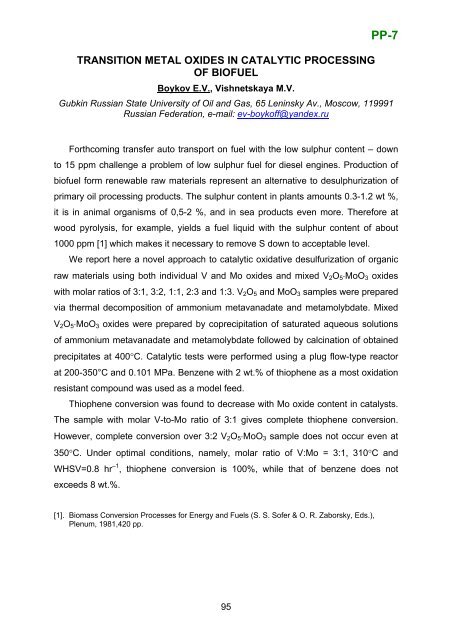Boreskov Institute of Catalysis SB RAS, Novosibirsk, Russia
Boreskov Institute of Catalysis SB RAS, Novosibirsk, Russia
Boreskov Institute of Catalysis SB RAS, Novosibirsk, Russia
- No tags were found...
Create successful ePaper yourself
Turn your PDF publications into a flip-book with our unique Google optimized e-Paper software.
TRANSITION METAL OXIDES IN CATALYTIC PROCESSINGOF BIOFUELBoykov E.V., Vishnetskaya M.V.PP-7Gubkin <strong>Russia</strong>n State University <strong>of</strong> Oil and Gas, 65 Leninsky Av., Moscow, 119991<strong>Russia</strong>n Federation, e-mail: ev-boyk<strong>of</strong>f@yandex.ruForthcoming transfer auto transport on fuel with the low sulphur content – downto 15 ppm challenge a problem <strong>of</strong> low sulphur fuel for diesel engines. Production <strong>of</strong>bi<strong>of</strong>uel form renewable raw materials represent an alternative to desulphurization <strong>of</strong>primary oil processing products. The sulphur content in plants amounts 0.3-1.2 wt %,it is in animal organisms <strong>of</strong> 0,5-2 %, and in sea products even more. Therefore atwood pyrolysis, for example, yields a fuel liquid with the sulphur content <strong>of</strong> about1000 ppm [1] which makes it necessary to remove S down to acceptable level.We report here a novel approach to catalytic oxidative desulfurization <strong>of</strong> organicraw materials using both individual V and Mo oxides and mixed V 2 O 5 ⋅MoO 3 oxideswith molar ratios <strong>of</strong> 3:1, 3:2, 1:1, 2:3 and 1:3. V 2 O 5 and MoO 3 samples were preparedvia thermal decomposition <strong>of</strong> ammonium metavanadate and metamolybdate. MixedV 2 O 5 ⋅MoO 3 oxides were prepared by coprecipitation <strong>of</strong> saturated aqueous solutions<strong>of</strong> ammonium metavanadate and metamolybdate followed by calcination <strong>of</strong> obtainedprecipitates at 400°С. Catalytic tests were performed using a plug flow-type reactorat 200-350°С and 0.101 MPa. Benzene with 2 wt.% <strong>of</strong> thiophene as a most oxidationresistant compound was used as a model feed.Thiophene conversion was found to decrease with Mo oxide content in catalysts.The sample with molar V-to-Mo ratio <strong>of</strong> 3:1 gives complete thiophene conversion.However, complete conversion over 3:2 V 2 O 5 ⋅MoO 3 sample does not occur even at350°C. Under optimal conditions, namely, molar ratio <strong>of</strong> V:Mo = 3:1, 310°C andWHSV=0.8 hr –1 , thiophene conversion is 100%, while that <strong>of</strong> benzene does notexceeds 8 wt.%.[1]. Biomass Conversion Processes for Energy and Fuels (S. S. S<strong>of</strong>er & O. R. Zaborsky, Eds.),Plenum, 1981,420 pp.95
















